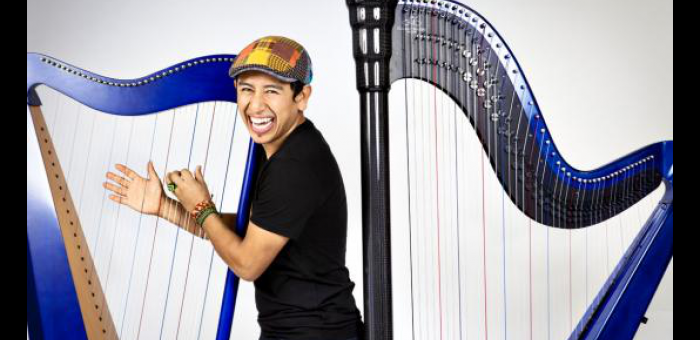Dec 9, 2025 12:28 PM
In Memoriam: Gordon Goodwin, 1954–2025
Gordon Goodwin, an award-winning saxophonist, pianist, bandleader, composer and arranger, died Dec. 8 in Los Angeles.…

Edmar Castañeda
(Photo: Courtesy of the artist)“My only advice,” said Winter JazzFest cofounder Adam Schatz to an audience at New York’s New School on Jan. 7, “is to go see something that you have no idea what it is, because it’s likely to steamroll you in a way you didn’t expect. And that’s secretly what this whole thing is about.”
Schatz was speaking on the second night of WJF’s two-night marathon—in which a multitude of artists play back-to-back 50-minute sets across the festival’s 12 venues in Manhattan’s Greenwich Village and Lower East Side. The setup encourages much foot traffic in the neighborhoods, which jazz promoters always welcome. And yet one of the nicer things about WJF is that one can usually stake out just a single venue for the evening, and sooner or later one of the mysteries Schatz speaks of will come to you.
Of course, that was likely not the case for the opener that evening at New School’s Fifth Floor Theater. Schatz spoke just before a performance by Mary Halvorson, the 36-year-old guitarist who is arguably the most original—and increasingly, influential—of her generation. The audience was not just packed; a line had formed out the door and nearly to the lobby’s elevator.
Leading nearly the same octet that graced her 2016 recording, Away With You, (with bassist Chris Lightcap substituting for her standby John Hébert), Halvorson actually began her composition “The Absolute Almost” as a sympathetic accompanist to lap steel guitarist Susan Alcorn. But they soon moved to unison as their bandmates—Lightcap, drummer Ches Smith and the quadruple horns of trumpeter Jonathan Finlayson, trombonist Jacob Garchik, and saxophonists Ingrid Laubrock and Jon Irabagon—slowly trickled in to accumulate into one terrific cacophony.
It was one of a number of highlights, which also included a delightful bit of tension between languid country-western-style picking (courtesy of Halvorson and Alcorn) and uproarious, loose avant-garde (courtesy of the horns) in their closing tune.
Less crowded, though, was the next act, Ben Goldberg’s Invisible Guy. The clarinetist led a trio with keyboardist Michael Coleman and drummer Hamir Atwal, one that he immediately steered into dark musical territory with the appropriately titled “Weeping Sad and Lonely.” Atwal skittered quietly with broom brushes over quiet drones from Coleman’s organ; Goldberg ruminated in tones so low that his ax might be mistaken for a bass clarinet.
There was a good deal of this darkness, though it was also illuminated by Coleman’s playful shimmy “Scientology” and the swinging “9 + 5,” which found Atwal assuming tight rhythmic control while Coleman and Goldberg simultaneously excavated a pretty, sprightly melody and a splashy harmonic no-mans-land.
Meantime, Goldberg adopted still another mood for his between-song banter, with the somewhat dour gravitas of a high-school principal or an NPR announcer.
That could never be said of his successor on stage, Colombian harpist Edmar Castañeda, who led octet billed as his World Ensemble. Theirs was a set of joy and passion that was easily the evening’s peak. If Castañeda was often in dialogue with his cohorts, such as with harmonicist Grégoire Maret on the opening “Entre Cuerdas” and a unison bout with trombonist Marshall Gilkes on “For Jaco” (on which the harpist did indeed play funk lines approximating the titular electric bassist), he was just as often in a captivating trance.
Even as he tangled with Gilkes, the leader seemed to be in a fever dream, moving over his instrument like a priest in a shamanistic ritual—percussionist David Silliman adding to that mood with his exotic chimes. On Castañeda’s astonishing solo performance of “Jesus De Nazareth,” what had been ritualistic became catharsis, his face and body both contorting with passion as the playing became increasingly intense. When it ended, his meek pronunciation of “Amen” felt earned.
Elsewhere in the evening, the promise of seeing something unknown met its limit. This writer had never before heard of Deva Mahal, and was surprised to learn on arrival at Avenue C’s Nublu that she was the daughter of blues legend Taj Mahal. Alas, her music came closer to that of Rihanna, with pop and radio-friendly R&B stylings the dominant motif in her set. It was perfectly fine, serviceable stuff, even a crowd-pleaser—but WJF embraces cutting-edge jazz, and this wasn’t it. A minor, unsatisfying blemish, however, in a stunning marathon. DB

Goodwin was one of the most acclaimed, successful and influential jazz musicians of his generation.
Dec 9, 2025 12:28 PM
Gordon Goodwin, an award-winning saxophonist, pianist, bandleader, composer and arranger, died Dec. 8 in Los Angeles.…

Nov 13, 2025 10:00 AM
For results of DownBeat’s 90th Annual Readers Poll, complete with feature articles from our December 2025 issue,…

Flea has returned to his first instrument — the trumpet — and assembled a dream band of jazz musicians to record a new album.
Dec 2, 2025 2:01 AM
After a nearly five-decade career as one of his generation’s defining rock bassists, Flea has returned to his first…

“It’s a pleasure and an honor to interpret the music of Oscar Peterson in his native city,” said Jim Doxas in regard to celebrating the Canadian legend. “He traveled the world, but never forgot Montreal.”
Nov 18, 2025 12:16 PM
In the pantheon of jazz luminaries, few shine as brightly, or swing as hard, as Oscar Peterson. A century ago, a…

Dec 11, 2025 11:00 AM
DownBeat presents a complete list of the 4-, 4½- and 5-star albums from 2025 in one convenient package. It’s a great…